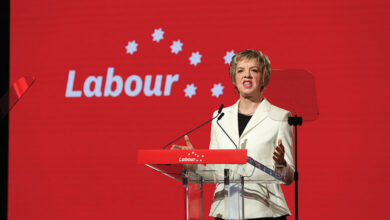UK general election 2024: Unionism gravitates away from the DUP
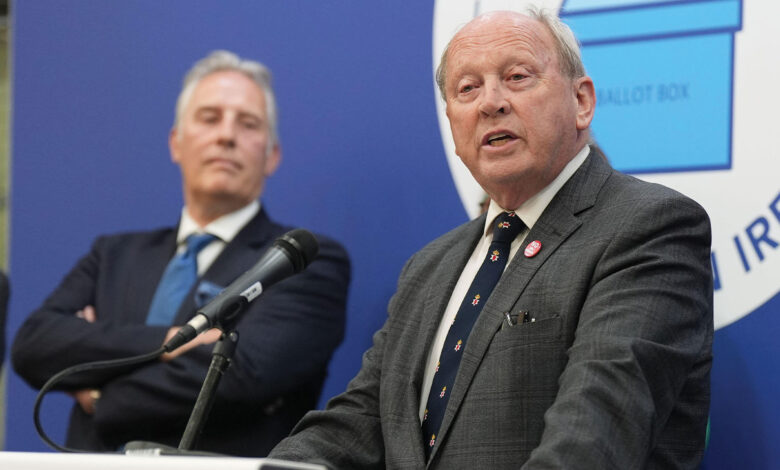
The UK general election of 4 July 2024 has brought a new British government. In Northern Ireland, this election heralded the first steps of the much-mooted realignment of unionism while Sinn Féin consolidated its dominance of nationalist politics, writes Joshua Murray.
Across the Irish Sea, the general election campaign had been accompanied with a vast array of opinion polling leaving little doubt that the Conservative Party was on course for a colossal defeat and a return to power for the Labour Party for the first time since 2010.
In the north, however, MPs are elected from completely different parties to the same parliament, and the scale of the change to take place among our cohort of MPs was unknowable before polling. Standout results include the collapse of the Paisley dynasty in North Antrim after 54 years, the unseating of Alliance Party deputy leader Stephen Farry in North Down, and Sinn Féin emerging as the largest northern party – and fifth largest overall – in the House of Commons.
Sinn Féin is the clear winner of this election and has now completed a hat trick: it now holds the most seats in the Northern Ireland Assembly, in Westminster, and at local government level, success which party leader Mary Lou McDonald TD has argued is a mandate for the holding of an Irish reunification referendum.
For the DUP, it was a disappointing election result, but not for unionism as a whole. While the DUP now stands reduced from eight to five seats, two of those losses were to other unionists. In North Down, independent unionist and former DUP MLA Alex Easton MP secured a place in the House of Commons at the expense of Alliance deputy leader Stephen Farry, while the UUP’s decision to parachute in then-Health Minister Robin Swann MP to successfully contest the South Antrim seat – at the expense of the DUP’s Paul Girvan – now appears well judged.
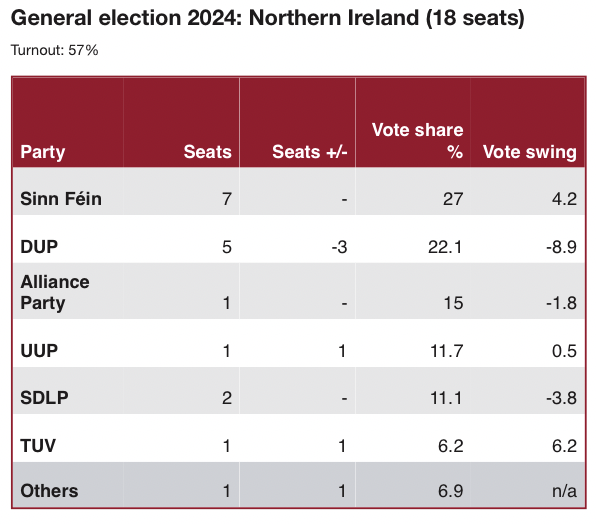
DUP with wounds to lick
The decision by Alliance Party leader Naomi Long MLA to run, despite being the Executive’s sitting Justice Minister, meant that newly appointed DUP leader Gavin Robinson MP faced a tight contest in east Belfast. In the end though, his margin of victory over Alliance increased.
However, far from comfortable was the DUP’s North Antrim race. TUV leader Jim Allister’s initial confidence was widely dismissed, but as the votes were tallied, reality dawned that Allister, aged 71, was set to become the oldest person to be first elected to the House of Commons since 1929, making him the first MP not called ‘Ian Paisley’ to represent North Antrim since 1970.
Allister has claimed that his election victory was the result of unionist backlash against the DUP’s support for the ‘sea border’ created by the now-ousted Tory government’s Windsor Framework. However, the fact that the DUP also lost to the nonaligned Alliance Party in Lagan Valley, and to a relative moderate in Robin Swann in South Antrim shows that there is more to this DUP decline than meets the eye.
With three different parties unseating the DUP, it is impossible to fathom that the Jeffrey Donaldson court case played a role in the decline of the DUP. Donaldson, who stated in a letter to his party that he strenuously contests historical allegations of rape and sexual assault against him, had been Northern Ireland’s longest serving MP, most recently securing a majority of 6,499 in Lagan Valley in 2019.
However, as Donaldson exited politics to face his trial, Jonathan Buckley MLA, who had been drafted in from Upper Bann to contest for the DUP, was unable to retain the seat for the party, with DUP leader Gavin Robinson MP acknowledging the “very difficult and challenging circumstances” which Buckley faced. For the first time since the constituency was created in 1983, Lagan Valley elected a non-unionist MP with Alliance’s Sorcha Eastwood MP entering the House of Commons.
While this election was a bruising one for the DUP, it was very nearly an absolute catastrophe, with party veterans Gregory Campbell MP and Sammy Wilson MP both holding their seats by the narrowest of margins amid ferocious competition from Sinn Féin in East Derry and Alliance in East Antrim respectively.
In a vote that required a recount, Sinn Féin very nearly pipped the DUP to attain the East Derry seat. While Campbell had previously held a majority of close to 10,000 in 2019, the republican party ultimately lost by 179 votes. A surprising feat for a party which had been perceived as lacking momentum following below-par performances in the Republic’s local and European elections one month prior.
Sinn Féin’s continued northern march
Superficially, Sinn Féin gained no seats in this election. Beneath the surface, however, the party increased its vote share in almost every constituency in which it stood. Alongside the successful blooding of three new MPs, its proximity to victory in what was considered a safe unionist seat in East Derry, while reducing the SDLP’s then-leader Colum Eastwood MP’s majority in Foyle from around 17,000 to just over 4,000, all add up to what will be considered an objectively successful campaign and, from the party’s perspective, an emphatic mandate for abstentionism.
Heading into the election, the party was in recovery mode after bruising local and European election results in the State, and was the only large party facing elections in both states in Ireland.
Arguably the most significant development in this election for Sinn Féin was when former General Secretary of the Royal College of Nursing (RCN), Pat Cullen MP, was unveiled by the party as the candidate in the traditionally ultra-marginal Fermanagh and South Tyrone.
Cullen secured an 8.9 per cent margin over the Ulster Unionist Party’s Diana Armstrong, amounting to a majority of 4,571, which is on a par with Michelle Gildernew’s 2005 majority when the unionist parties did not commit to an electoral pact.
Although Mary Lou McDonald TD has ostensibly taken the results as a mandate for the holding of a referendum on Irish reunification, the new Labour government in Britain and Taoiseach Simon Harris TD have ruled out a referendum in the immediate term. However, recently departed Taoiseach and Fine Gael leader Leo Varadkar TD has called on the next Irish government to prioritise taking the steps towards Irish unity in the next Dáil, for which an election is due by March 2025.
The SDLP has maintained its role in ensuring that nationalist MPs sit in the House of Commons. While this is a point of contention for some republicans, the fact that Sinn Féin maintains its absence from the House of Commons while the SDLP takes the Westminster plunge could, from a nationalist perspective, play complementary roles in securing nationalism’s broad objectives. However, as 2017 showed, Sinn Féin does have the capability of wiping out the SDLP.
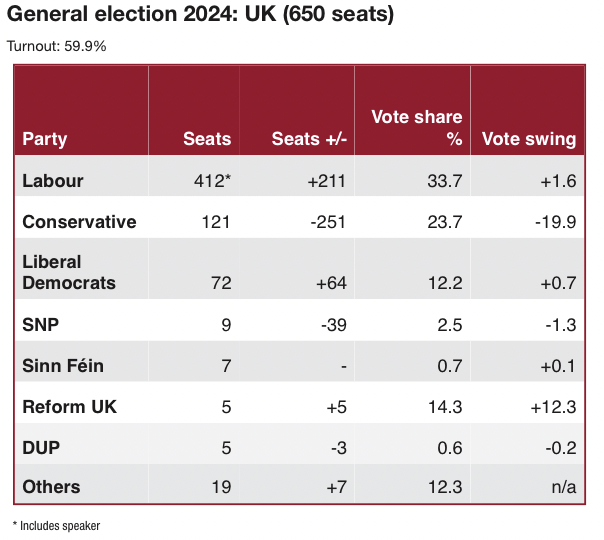
Labour’s ‘broad and shallow’ landslide
While Labour’s victory, in seat terms (411 of the 650 House of Commons seats), is essentially on a par with Tony Blair’s 1997 and 2001 landslides, the party underperformed in the polls in popular vote terms, only garnering a 33.7 per cent share (as the UK uses a first-past-the-post electoral system) of the popular vote despite polls consistently projecting that Labour would win at least 40 per cent. Labour’s victory is the smallest vote share to secure a majority government in British history.
While it made hundreds of seat gains from the Tories, Labour also recorded some losses. Most prominently, it lost Islington North to former party leader Jeremy Corbyn MP, who ran as an independent after being refused the party whip by Starmer, and elsewhere to four independents who campaigned for a ceasefire in Gaza.
The Labour Party was the beneficiary of a complete vote collapse for the Conservative Party, which won only 121 seats, its worst election result since the early 19th century both in seat terms and popular vote terms, as the party secured only 24 per cent of the popular vote. The Tories lost votes in all directions, with five seats lost to Nigel Farage MP’s Reform UK, two seats to the Green Party, losing a seat to the SNP (despite the SNP being virtually wiped out in Scotland and finishing just two seats ahead of Sinn Féin), to Labour in overwhelming numbers, and to the Liberal Democrats in overwhelming numbers.
The scale of the Tory defeat can be summarised by the fact that four of the five seats held by the Tory prime ministers since 2010 were lost. In addition, 12 cabinet secretaries lost their seats, joined in their defenestration by arch-Brexiteers Jacon Rees-Mogg and Steve Baker.
Reflections
This election was a disappointment for the DUP, but far from disastrous for unionism more broadly. What Gavin Robinson MP described as the “very difficult and challenging circumstances” around the charging of Jeffrey Donaldson seems to have played a role in the DUP losing Lagan Valley. However, more fundamental introspection is needed for the DUP as it lost to its right in North Antrim and to its left in South Antrim.
For Alliance, this election was very much a subpar performance, with Stephen Farry’s heavy defeat in North Down and Naomi Long’s failure to gain east Belfast being somewhat offset by the gain of Lagan Valley. Furthermore, strong second place performances in East Antrim and Strangford mean that the party has something to build on.
For nationalism, Sinn Féin can be satisfied with its performances and a clear pathway to potential future gains in East Derry and Foyle, as well as successfully carrying out successions in Fermanagh and South Tyrone, Newry and Armagh, and Mid Ulster, where the party had popular incumbents pre-election.
With a new Labour government taking power in Britain, there has already been a much vaunted “reset” promised by the new Prime Minister Keir Starmer MP in British-Irish relations, and the most profound implications of this election for Northern Ireland from the other side of the Irish Sea may be a renegotiation to come on Britain’s Brexit deal with the EU, a new approach to legacy, the potential uplift of public finances, and reforming Stormont, something which has been supported by new Secretary of State Hilary Benn MP.
New British Secretary of State for Northern Ireland
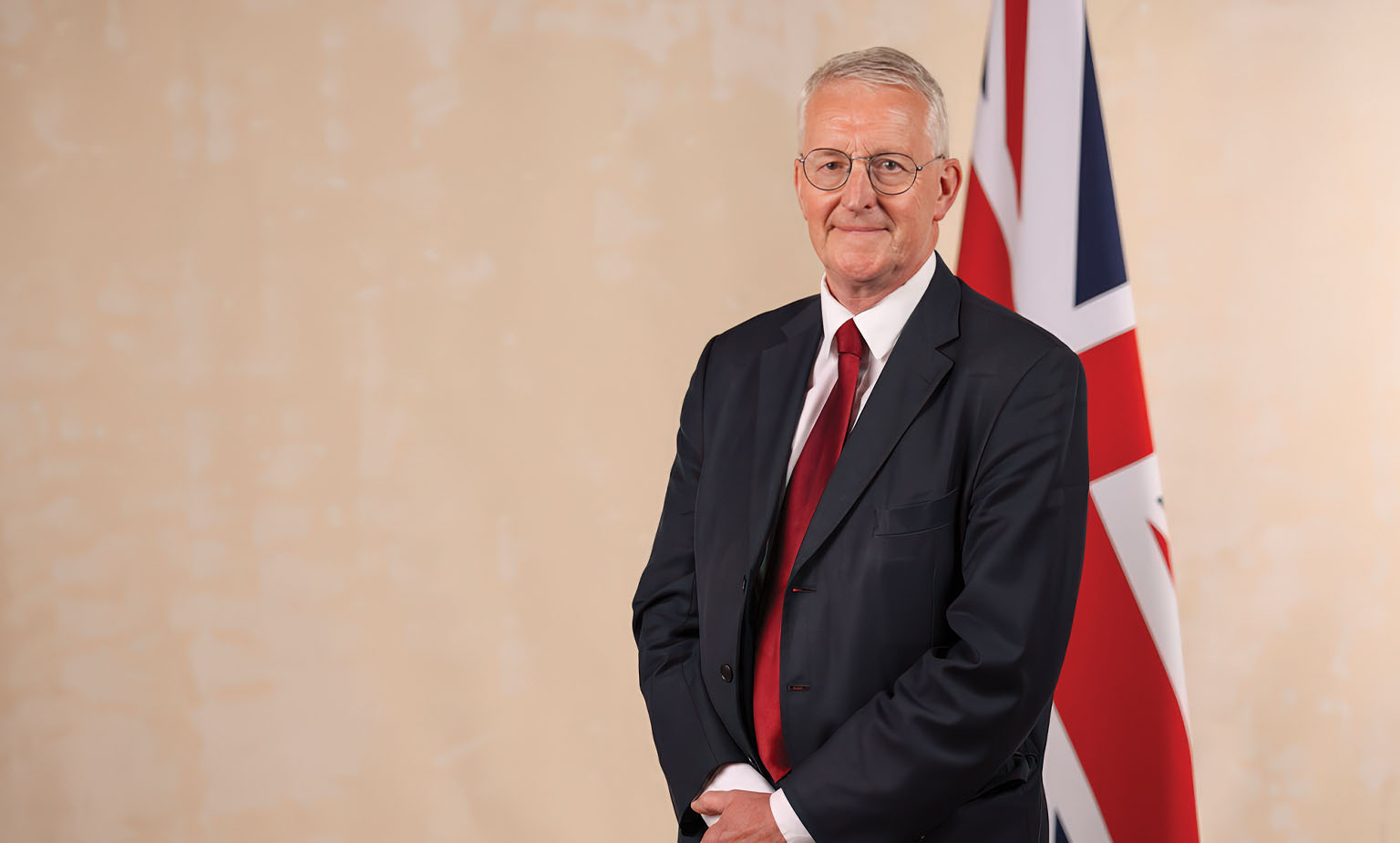
Hilary Benn MP is arguably the most high-profile appointee as Northern Ireland Secretary since Peter Mandelson in 1999. Benn is a political veteran and has mirrored comments by the new Prime Minister on the need for a “reset” of British-Irish relations.
A Leeds MP since a 1999 byelection, Benn was appointed as Shadow Northern Ireland Secretary in September 2023, marking a return to the frontline of politics seven years after he had been sacked by former party leader Jeremy Corbyn MP from the frontbench in 2016.
An arch ‘remainer’, Benn was a key player in the ultimately unsuccessful People’s Vote campaign for the UK to remain in the EU after the 2016 referendum vote to leave. Although unsuccessful, his interest in EU affairs promoted him to publish a report titled How to Fix the Northern Ireland Protocol alongside the Centre for European Reform – amid northern loyalist fears over the ‘Irish Sea border’ – where he emphasised the importance of avoiding border infrastructure on the island of Ireland while adhering to Brexit requirements.
With a new administration now in place in Downing Street, there is no doubt that competent actors are overseeing Northern Ireland from London, and Labour will be keen to be interpreted by observers as successful on Northern Ireland, with the legacy of the Good Friday Agreement in 1998 and St Andrews Agreement in 2007 claimed by the party as core achievements of the Tony Blair government. Whether challenges such as legacy, local finance mechanisms, a potential new Brexit deal, and the debate on Irish reunification can be met by the new British Government, however, remains to be seen.



